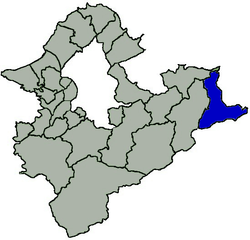Gongliao District
| Gongliao 貢寮區 | |
|---|---|
| District | |
| Gongliao District | |
|
Farmland and hills in Gongliao District | |
 Gongliao District in New Taipei City | |
| Coordinates: 25°1′N 121°54′E / 25.017°N 121.900°ECoordinates: 25°1′N 121°54′E / 25.017°N 121.900°E | |
| Country | Taiwan |
| Special municipality | New Taipei City |
| Area | |
| • Total | 38.60 sq mi (99.97 km2) |
| Population (January 2016) | |
| • Total | 12,858 |
| Time zone | +8 |
| Website | www.gongliao.ntpc.gov.tw (Chinese) |
Gongliao District (Chinese: 貢寮區; pinyin: Gòngliáo Qū; Pe̍h-ōe-jī: Kòng-liâu-khu; literally: "gift hut") is a rural district in the eastern part of New Taipei City, Taiwan.[1] It is the most eastern district on the main island of Taiwan and at its most eastern tip is Cape of San Diego.
History
During the period of Japanese rule, Gongliao was called Kōryō Village (貢寮庄), and was governed under Kīrun District, Taihoku Prefecture.
Geography
The area of the district is approximately 99.97 square kilometers. There are about 14,077 people living in the district.
Fulong Beach
Fulong Beach, also known as Fulong Bathing Beach (福隆海水浴場), is located at Fulong Village, Gongliao Township, New Taipei City at Northeastern Taiwan. It is the outlet of the Shuang River.
The sands there are golden, which is rare in Taiwan. Nearby is a camping site named Longmen. This beach is a favorite in the summer for people living in northern Taiwan. It is also a popular area for surfing, windsurfing, and fishing.
The Shuang River divides the beach into inner and outer parts. There is a footbridge named Rainbow Bridge (彩虹橋) linking the two parts. However, the watercourse of the river varies every year to some extent; sometimes the bridge is functional; other times it is not, because the seaside end would be in the river or in the sea.
Since 2000, the Hohaiyan Rock Festival (貢寮國際海洋音樂祭) has been held here for 3 to 5 days in the summer. Normally, it takes place in mid-July, but sometimes it has been delayed due to typhoon interruption or damage to the band shell facilities. Also the watercourse of the Shuang River sometimes changes shape or size, influencing the location of these temporary band shells.
Aodi, Taiwan
Aodi (sometimes Audi, Aoti, Auti; Chinese: 澳底) is a small fishing village in Gongliao. It is a popular tourist destination owing to its scenic setting and many seafood restaurants. It is also close to the controversial Lungmen Nuclear Power Plant, under construction since 1999. A nearby beach, Yenliao (鹽寮), was the site of the first landing for the Japanese invasion of Taiwan in 1895.
Tourist attractions
- Fulong Beach and Hohaiyan Rock Festival
- Cape San Diego Lighthouse at the Cape of San Diego
- Yanliao Beach Park
- Old Tsau Ling Tunnel (草嶺古道)
Infrastructure
Taiwan's fourth nuclear power plant is under construction in Gongliao. Construction of the plant is opposed by most of the community's residents.
Transportation
Notable natives
- Puff Kuo, model, actress and singer
See also
| Wikimedia Commons has media related to Gongliao District, New Taipei. |
